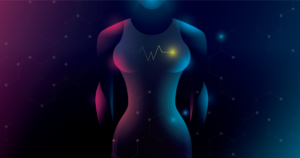Digital therapeutics and software-powered medicine infographic summarizes how we can improve outcomes when combined DT with standard therapy treatments.
Featured Programs
Digital Therapeutics: Software-Powered Medicine
By 2025, the market for digital therapeutics is expected to reach $7.8 billion
The Promise of Software-Powered Medicine
What Are Digital Therapeutics (DTx)?
- Therapeutic interventions driven by technology and software programs
- Used to alleviate symptoms of physiological and neurobehavioral conditions
- Therapies improve outcomes when combined with standard treatments
The Benefits Of DTx
- Digital Treatment
- Offers new options for otherwise unmet needs
- It May help reduce reliance on medication
Wide-Ranging Applications
- Diabetes
- Obesity
Diseased systems, including
- Respiratory
- Cardiovascular
- Central nervous
- Gastrointestinal
What Can DTx Do?
Combining surgical tools and digital software surgeons can not relieve tremors without invasive surgeries
Tech-Powered Tremor Relief
Exablate Neuro has been used in over 50 medical centers around the world to treat over 2,000 patients. Some things that may relieve symptoms
- Essential Tremors: Involuntary trembling of extremities and speech
- Parkinson’s Disease: Uncontrollable bodily movements
How It Works
The treatment combines the use of MRI imaging, high-intensity ultrasound, and a specialized cooling helmet
High-intensity ultrasound
- Sees through skin to the bone
- Targets the Vim point to reduce the tremor
Magnetic resonance imaging (MRI)
- Guide the procedure and prevents damage to healthy tissue
- Monitor the patient’s temperature in the area
Cooling Helmet
- Controls the patient’s skull temperature
- Prevents overheating from ultrasonic heat production
The Benefits of DTx
- Non-invasive & minimal risk
- Lower risk of infection
- Shorter recovery time
- No collateral tissue damage
Potential side effects
- Tingling in fingers and tongue
- Difficulty with a sense of balance
- Usually temporary and relatively minor
Specialized video games help patients practice essential skills, from attention and memory to relaxation, all while having fun
Video Games As Medicine?
Video games may help builds key skills, including
- Working Memory: Short term ability to recall information such as a to-do list
- Executive Functioning: Ability to manage emotions, attention, and planning
- Selective Attention: Processing, filtering and responding to competing stimuli
Akili Interactive’s Selective Stimulus Management Engine (SSME™)
- Gameplay is specially designed to utilize key skills
- Adaptive algorithms adjust to each player’s skill level
Sensory and motor stimuli are deployed too:
- Target and activate key areas of the brain
- Build new neurological links through regular practice
It May help alleviate symptoms of
- ADHD
- Autism
- Multiple sclerosis
- Major depression
More On The Way
New gaming engines are currently in development
- Spatial Navigation Engine (SNAV™)
- Affective Engine (AAFF™)
These new engines are designed to help patients with
- Traumatic brain injuries
- ICU delirium
- Lupus
Gaming With Biofeedback
How Does It Work? Biofeedback is used to indicate the patient’s anxiety or attention level
- Heart rate monitor: Tracks pulse rate and volume
- Respirometer: Tracks breathing and exhalations
- Temperature: Tracks peripheral blood flow
- Skin Conductance Level: Monitors for sweat gland activity
- Galvanic Skin Response: Monitors for muscle tension
- Eye Tracking: Monitors attention to the task
Gameplay adapts to the player’s state of mind and requires a mindful response to continue
- Mighteor: Play becomes more difficult as anxiety increases, requiring the player to independently relax in order to continue
- Quotient: Slows gameplay as attention wanders, requiring the player to practice selective focus in order to continue
May Help Alleviate Symptoms
- Anxiety
- ADHD
- Autism
Cutting-Edge Therapies: New & Coming Soon
In 2018, Pear Therapeutics launched the first digital rehabilitation platform to gain FDA approval
- reSET for Substance Use Disorder
- reSET-O for Opioid Use Disorder (OUD)
Both programs provide digital cognitive behavioral therapy to complement outpatient treatment
An Israeli startup VRHealth began testing a virtual reality for pain management
- Immersive VR experiences distract patients from the pain
- Combined with physical therapy to address underlying issues
- Emerging research shows promising uses for digital diagnosis and treatment
- Eye Tracking: May help streamline the diagnosis of Autism and symptoms levels
- Voice Markers: May help track Alzheimer’s, depression, schizophrenia, and Parkinson’s disease
- Neurologic Music Therapy: May improve motor, speech, and cognitive function after disease or injury
Are digital therapies the next frontier in medicine?
Related:

